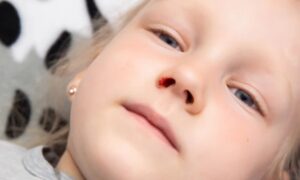As parents, one of the biggest concerns is a child's health, especially when they develop a rash. When red spots appear on their skin, many parents worry about whether it’s measles or hives. However, these two conditions have clear differences. In this article, I’ll explain their symptoms, causes, treatments, and how to distinguish between them, so you can better understand these common skin issues.
1. What is Measles?
Measles is a highly contagious respiratory disease caused by a virus, most commonly seen in children. It often peaks in early spring and winter. Measles is transmitted through the air, and its main symptoms include fever, cough, runny nose, and red eyes. This is followed by the appearance of red rashes on the skin, usually starting on the face and spreading across the body.
Common Symptoms of Measles:
- Fever: This is usually the first symptom, with a temperature that can rise to 39-40°C (102-104°F).
- Catarrhal symptoms: These resemble cold symptoms, such as cough, runny nose, and red eyes.
- Koplik spots: Small white spots may appear inside the mouth early in the disease, known as “Koplik spots,” which are a typical sign.
- Red rash: The rash usually appears after the fever starts, beginning behind the ears and on the face, gradually spreading to the entire body.
Measles is very contagious, so if a child is diagnosed with it, it’s important to keep them isolated to prevent spreading it to others. Since there is no specific medicine to cure measles, treatment mainly focuses on relieving symptoms, such as reducing fever and ensuring adequate rest and hydration. Vaccination with the MMR vaccine (measles, mumps, and rubella) can effectively prevent measles.
2. What is Hives?
Hives, also known as urticaria, is a skin condition caused by an allergic reaction. It can be triggered by various factors, such as food allergies (like seafood or nuts), medication, and environmental factors (like pollen or dust). Some cases of hives may appear suddenly and disappear quickly, while others can last for several days or weeks.
Common Symptoms of Hives:
- Red or white welts: Raised, itchy welts that may appear as red or white patches on the skin.
- Appearance on different body parts: The welts may appear randomly and disappear on their own, only to reappear in other areas.
- Intense itching: Children may feel intense itching, which can lead to scratching and possible skin damage.
Hives often go away on their own within a short period. For chronic cases, antihistamines are commonly used to relieve symptoms. Identifying and avoiding triggers that cause hives is also essential for managing the condition.
3. How to Differentiate Between Measles and Hives?
The main differences between measles and hives lie in their causes and symptom patterns. Simply put, measles is a contagious disease caused by a viral infection, while hives is a skin allergy that is not contagious.
- Duration of symptoms: Measles symptoms, including fever and rash, usually last about a week, whereas hives can disappear within hours and then reappear.
- Rash appearance: Measles rash is made up of small red dots that spread from the face to the body, while hives are raised welts that appear randomly and itch intensely.
- Additional symptoms: Measles is often accompanied by fever, cough, and Koplik spots, whereas hives usually only cause itching and have no respiratory symptoms.
In short, if your child has cold-like symptoms along with a quickly spreading rash, it’s likely measles. If there are only itchy, raised patches without other cold symptoms, it’s probably hives.
4. What Should Parents Do?
If you suspect that your child has measles or hives, here are some steps to take:
- Observe symptoms: If your child has a high fever and rapidly spreading rash, seek medical attention promptly to rule out measles. For occasional itchy welts that look like hives, you can monitor them at home initially.
- See a doctor: Measles requires a doctor’s diagnosis, especially if the fever doesn’t go down. Hives can usually be managed with antihistamines, but chronic cases also warrant a doctor’s consultation.
- Avoid triggers: For hives, it’s best to avoid known allergens, such as specific foods or environmental triggers.
5. Case Studies
To help you better understand the differences, here are some real-life examples.
Case 1: Linda, a 5-year-old girl, suddenly developed a fever, with a temperature nearing 39°C (102°F), along with a cough and runny nose. Her parents initially thought it was a common cold, but the next day, red spots appeared on her face and behind her ears, and the rash quickly spread to her entire body. After a doctor’s examination, she was diagnosed with measles. The doctor advised isolation and plenty of fluids to prevent dehydration. With about a week of care, Linda gradually recovered, her fever subsided, and the rash faded.
Case 2: Tom, an 8-year-old boy, developed red, itchy welts on his face after dinner, which were highly irritating. His parents recalled that he had eaten crab, which he may be allergic to, causing the hives. They applied an antihistamine cream prescribed by the doctor and encouraged Tom to drink plenty of water. A few hours later, the welts gradually disappeared, and the itching subsided.
These cases show that while measles and hives both involve rashes, their causes and treatments are very different. Measles requires isolation and a doctor’s guidance, while hives can often be managed by avoiding triggers and using antihistamines.
6. Conclusion
Measles and hives are both common in children, but they differ greatly. Measles is a viral infection that needs isolation and medical care, while hives are often caused by allergies and can be prevented by avoiding triggers.
As parents, knowing the difference can help you make better decisions when your child shows symptoms and take the right steps for their care. If you’re ever unsure about your child’s condition, it’s always safest to consult a doctor for professional advice.
References
- Mayo Clinic - "Measles (Rubeola)."
- CDC - "Signs and Symptoms of Measles."
- NHS - "Measles Overview" and "Hives (Urticaria)."
- American Academy of Pediatrics - "Common Childhood Skin Conditions."
- WHO - "Measles."
- DermNet NZ - "Urticaria (Hives)."
- KidsHealth by Nemours - "Measles" and "Hives (Urticaria)."








